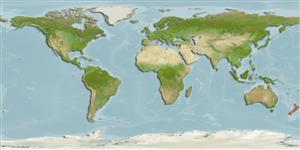Environment: milieu / climate zone / profondeur / distribution range
Écologie
marin pelagic-neritic; profondeur 0 - ? m. Temperate
Southwest Pacific: restricted to New Zealand, including the Chatham Islands.
Taille / Poids / Âge
Maturité: Lm ? range ? - ? cm
Max length : 26.0 cm SL mâle / non sexé; (Ref. 10988); common length : 22.0 cm TL mâle / non sexé; (Ref. 9258)
Description synthétique
Clés d'identification | Morphologie | Morphométrie
Épines dorsales (Total) : 0; Rayons mous dorsaux (Total) : 15 - 18; Épines anales: 0; Rayons mous anaux: 17 - 20; Vertèbres: 55 - 58. Gill rakers usually 32 or less on the first arch and 25 or less on the second arch. Relatively longer upper jaw (usually longer than wide) and lower jaw (usually longer than head length), especially at larger sizes.
Body shape (shape guide): eel-like.
Occurs in inshore waters. Forms schools for spawning during mid summer (Ref. 9258). Feeds mainly on larger zooplankton like mysids, crab larvae and polychaete larvae (Ref. 26966).
Life cycle and mating behavior
Maturité | Reproduction | Frai | Œufs | Fécondité | Larves
Collette, B.B., 1974. The garfishes (Hemiramphidae) of Australia and New Zealand. Records of the Australian Museum 29(2):11-105. (Ref. 10988)
Statut dans la liste rouge de l'IUCN (Ref. 130435: Version 2025-1)
Menace pour l'homme
Harmless
Utilisations par l'homme
Pêcheries: intérêt commercial mineur
Outils
Articles particuliers
Télécharger en XML
Sources Internet
Estimates based on models
Phylogenetic diversity index (Réf.
82804): PD
50 = 0.5000 [Uniqueness, from 0.5 = low to 2.0 = high].
Bayesian length-weight: a=0.00102 (0.00046 - 0.00225), b=3.06 (2.88 - 3.24), in cm total length, based on all LWR estimates for this body shape (Ref.
93245).
Niveau trophique (Réf.
69278): 3.2 ±0.3 se; based on diet studies.
Résilience (Réf.
120179): Haut, temps minimum de doublement de population inférieur à 15 mois (Preliminary K or Fecundity.).
Fishing Vulnerability (Ref.
59153): Low vulnerability (22 of 100).
🛈
Climate Vulnerability (Ref.
125649): High to very high vulnerability (73 of 100).
🛈
Nutrients (Ref.
124155): Calcium = 240 [58, 580] mg/100g; Iron = 0.655 [0.226, 1.848] mg/100g; Protein = 17.8 [15.0, 20.0] %; Omega3 = 0.518 [0.215, 1.478] g/100g; Selenium = 6.33 [2.15, 16.41] μg/100g; VitaminA = 59.3 [11.7, 294.2] μg/100g; Zinc = 0.776 [0.306, 2.099] mg/100g (wet weight); based on
nutrient studies.
